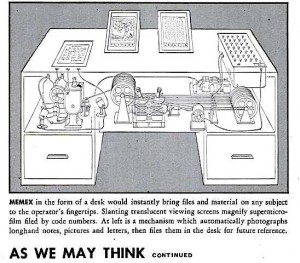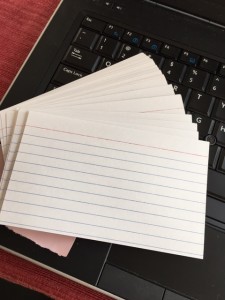Like other scientists involved in producing weapons of mass destruction for WWII, Vannevar Bush eventually issued a clarion call to his colleagues to create “pacific instruments,” namely machines capable of collecting “the inherited knowledge of the ages.” This week I read his famous July 1945 essay, “As We May Think” and immediately recognized his memex as a proto-computer with the ability to create associative trails of information. Unlike the atomic bomb, which Bush oversaw, the memex’s purpose was constructive: by enabling scientists to select, annotate, and associate bits of information from myriad sources, the machine would allow them “to grow in the wisdom of [human] race experience” and “wield that great record [of human knowledge] for his [man’s] true good.” I confess I had to reread the final paragraphs several times to grasp Bush’s meaning; he abruptly shifts from “we” (a pronoun encompassing him and his fellow scientists) to “he” (which references Man or mankind—as in the phrase, “Presumably man’s spirit should be elevated . . . “). Yet, for all his visionary ideas about the future, Bush’s optimism that July was clearly measured. Allied troops had just recently liberated the death camps and he undoubtedly knew more about the genocide than the general public. As director of the Manhattan Project, he also knew that Little Boy was even at that moment being readied for use against Japan. The US was still very much at war. Would mankind “perish in conflict” or “live healthily” ever after?
I found it difficult to read “As We May Think” while questions about our nation’s future are swirling. I live in a blue dot surrounded by a swath of red, an established refugee resettlement community in a historically WASP locale, a college town set in a proud but declining agricultural region. Open learning is central to who I am and what I do here, but many of my neighbors want to close our borders, reject freedom of conscience, and deride long-established scientific and humanistic knowledge. What to do at such a moment? I turn inevitably to my students.
This semester I am teaching Intro to Public History, a survey of the major branches of the field: historic preservation, oral history, museum exhibit design, living history, archives, and so forth. Over the years, I have added a lot of digital content, as well, and once again I am requiring students to create their own websites or portfolios (shoutout to UMW’s Domain of One’s Own for inspiration) as a way to not only acquire new skills but to think carefully about curating their own digital identities. The assignment intersects with Bush’s essay in interesting ways. Besides posting several research projects, they must reflect on the digital traces they have already left behind, the FB likes and Instagram posts, the Amazon purchases and texts and sexts and tweets and all manner of bits and bytes that linger in databases everywhere. The same machines that allow ‘we’ scholars to make associative trails for purposes that serve the public good are also used to data-mine for private profit. There is indeed “a new profession of trailblazers,” as Bush called them, “those who find delight in the task of establishing useful trails through the enormous mass of the common record.” Young people care a great deal about privacy and their personal brands, but they often lack the information or tools they need to protect themselves.
So many new tools exist now. The goal of this week’s openlearninghub exercise was to consider innovative ways of locating, selecting, and processing information. Many years ago when I was dissertating, I relied on two ordinary shoeboxes to hold the hundreds of notecards I needed for my research. The project, a study of cultural identity in a 19thC company town, required me to keep track of thousands of individuals and the million factoids I had gathered about them from census records, parish records, wage records, probate inventories, and oral histories. I also used a relational database called Paradox, which I loaded on a dinosaur of a portable computer, and two file cabinets full of folders containing Xeroxes and pages of longhand notes. But the shoeboxes with their alphabetical dividers were the heart and soul of my “philosophical genealogies.” If I had had a memex, they would have been my code book. Once, my partner-now-husband saw me laying out cards on a table as I struggled to link members of several Dougherty families. He said, “You know, that’s how the Nazis kept track of the Jews. Notecards. I wonder what they would have done with computers.” I think about my notecards a lot these days. The days of notecards are long gone.

